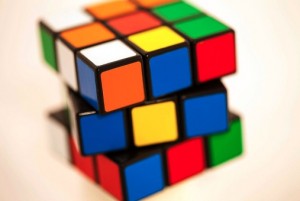 Invented in the 1970s, the Rubik’s Cube fascinates people around the globe and is one of the world’s best-selling toys. While many fans found the magic cube a hard nut to crack, a German toy manufacturer has challenged the registered trademark for the 3-dimensional shape of the cube before the General Court (European Union). The Court has now decided that the trademark registration cannot be denied.
Invented in the 1970s, the Rubik’s Cube fascinates people around the globe and is one of the world’s best-selling toys. While many fans found the magic cube a hard nut to crack, a German toy manufacturer has challenged the registered trademark for the 3-dimensional shape of the cube before the General Court (European Union). The Court has now decided that the trademark registration cannot be denied.
In 1999, the British toy manufacturer Seven Towns, which manages the IP rights relating to the Rubik’s Cube, filed a Community trademark (CTM) application for the three-dimensional trademark (3D or three-dimensional trademark) with the Office for Harmonization in the Internal Market (OHIM) in Alicante.
In 2006, Simba Toys, a German company competing with Seven Towns Simba Toys, filed a request for a declaration of invalidity of the trademark on the grounds that the trademark merely involves a technical solution consisting of its rotating capability, thereby lacking the necessary distinctiveness. Simba argued that a technical solution can essentially only be protected by patents, but is not accessible to trademark protection.
The OHIM rejected the cancellation request, thereby causing Simba Toys to file an appeal against the decision with the General Court (EGC) in Luxembourg. However, according to a recent press release of the EGC this appeal was now dismissed (decision of November 25, 2014, case number: T-450/09).
The EGC noted that the essential features of the contested trademark are the shape of the mark on the one hand and the black lines on the sides making up part of the structure and dividing the grip into squares on the other hand. These two elements are clearly visible in the graphic representation of the trademark, which is required under Art. 4 CTMR. Consequently, the trademark can be protected as a CTM because it can be represented graphically and is also able to distinguish the goods or services of one party from those of other parties.
In the proceedings Simba Toys suggested that the relevant public will perceive the black lines as serving the function of dividing the cube into individual elements and serving a technical function because they enable the elements to be moved around. But the court did also not follow this argumentation. According to the court it is not the black lines or the grid that allows a movement of the elements, but the invisible rotating mechanism inside the Rubik’s cube. Therefore, the trademark cannot be denied registration as a CTM on this basis.
With regard to the requisite distinctive character of the mark it is the cubic grid structure which clearly differs in the contested trademark and the representation of other three-dimensional puzzles on the market. Therefore, the structure has a distinctive character which enables consumers to see the structure as an indication of the origin of the products.
Within a time limit of two months Simba Toys may still file an appeal against the decision of the EGC. The case would then be reviewed once more by the European Court of Justice (ECJ).
Conclusion:
Contrary to popular belief, trademark protection is not limited to word or figurative marks, but can also extend to other types of marks, such as 3D marks. A trademark directed to the shape of the product may under certain preconditions supplement the patent protection. A flanking protection by a trademark might have an economic impact because patent protection only lasts 20 years, whereas trademark protection may be extended indefinitely as long as the maintenance fees are duly paid.
Foto: © Sonny Abesamis, [CC BY 2.0]


I noticed that there was a trademark dispute for the Rubik’s cube in the US: Seven Towns / Dayan; for trade dress registration no. 1265094.
I would say that Seven Towns’ rights are thin at best. The company would do better to leverage its stronger trademark, i.e. the Rubik’s name itself, and innovate. Alternative cubes like those in the fields of speed cubes are outcompeting Rubik’s-branded cubes because they present dramatic functional – the province of patent law – improvements over the Rubik’s design.